September 30, 2023 – Volume 25, Issue 9
In This Issue
- Flanigan’s Net Positive: The End of Range Anxiety
- American Climate Corps
- Finding Synergies with Agrivoltaics
- Wine and CO2
- Tesla Moves Into Wireless EV Charging
- French Wind Trees
- London’s Bold Climate Action
- Flanigan’s Ego-Logic Podcast Updates
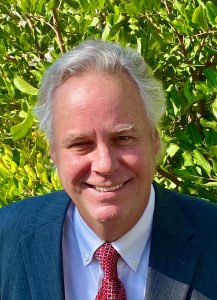
Flanigan’s Net Positive: The End of Range Anxiety
EV range used to be THE barrier to adoption of electric vehicles. Now with 300+ mile ranges it is A barrier only for some.
This caught my eye: Fisker is boasting that its 2026 Ronin model will have 600 miles of range. Revealed August 3rd, the concept car design model was on display… a sleek sports car, a luxury, carbon-fiber, hard-top convertible.
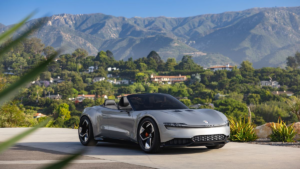
Image Courtesy of Fisker
Unlike a conventional EV underfloor battery pack – often known as the “sled” – the Ronin will use batteries integrated through the vehicle’s body structure to achieve its elevated range. Reserve one today with a $2,000 deposit. Then brace for the $385,000 starting price!
We look forward to Ronin’s cutting-edge technology, and more so far less expensive EVs that get 600+ miles per charge, eliminating EV range anxiety. Six hundred miles of range is more than a typical internal combustion engine vehicle. A Lexus RH 450 hybrid gets 30 MPG combined and has a 17.2 gallon fuel tank, and has a range of about 516 miles. Soon EVs will be on the market that beat that.
Right now, the Fisker Ocean claims to have the longest range of any electric SUV today – 360 miles. (Rivian’s 2023 R1S gets 321 miles.) The Ocean also has “some seriously funky features” such as “California Mode.” Push a button and eight glass panels simultaneously open to transform the SUV into a coastline-cruiser. The mode lowers windows, opens the SolarSky roof, and drops the rear liftgate window for surfboards.
That’s the fancy stuff. Now let’s get down to basics with mainstream car companies that build cars for the masses. Toyota has announced that its Performance Li-ion batteries expected in 2026, will deliver a range of over 500 miles. Toyota claims that these batteries will cost 20% less to produce compared to the battery technology in the Toyota bZ4X and will be capable of 80% recharge in 20 minutes.
More recently, Toyota presented its battery technology roadmap, promising 600-mile range EVs with 10-minute charging times from 2027 on. Ultimately Toyota is suggesting a range of 745 miles. That’s fantastic.
Toyota was slow in its support and adoption of EVs, but it holds more solid-state battery patents than any other automaker… even more than Panasonic. Its chemical engineers have been hard at work. Toyota has announced four new battery technologies, including a solid state battery and three new liquid electrolyte battery technologies that will increase range and power while reducing charging time and cost. As EV charging networks get built out with fast chargers along all major highways, it may be as easy to fill up your EV as it was your ICE vehicle.

Image Courtesy of Toyota
Quote of the Month
“Toyota Promises EVs with 10-Minute Recharging and 600-mile Range from 2027”
American Climate Corps

Image Courtesy of Climate Drift
Three cheers. The U.S. government has now broadened a successful mode. Now we have a new and peaceful “corps,” a force in the making. The new corps, the American Climate Corps, will focus on climate, guiding thousands of youth in climate-related jobs. Some consider it New Deal job creation. Its initial sites are on 20,000 students per year effectively entering careers fighting climate change. American Climate Corps is an interagency initiative of AmeriCorps, the Departments of Labor, Energy, Interior, Agriculture, and the National Oceanic and Atmospheric Administration. It is preparing American youth for jobs in clean energy and climate resilience.
In 1933 Franklin Delano Roosevelt created “the alphabet soup agencies” to get the country back to work after the Great Depression. The REC was formed, so was TVA, BPA, SEC, FAA, and over two dozen more… including the Civilian Conservation Corps (CCC). They were emergency relief programs to get the country back on track. There were agencies to regulate banks and the stock market, for debt relief, managing farms, electrification, industrial recovery, and public works construction projects. WPA crews built bridges and other forms of infrastructure across the country. The Civilian Conservation Corps put people back to work after the ravages of the Dust Bowl, the drought that devastated farmlands across the prairies. CCC crews planted three billion trees.
In 1955 Elizabeth Titus Putnam, a student at Vassar College, wrote her senior thesis on a “Proposed Conservation Corps.” Through connections, she was ushered into the Oval Office to meet with President Eisenhower who liked her idea for a Student Conservation Program, now the Student Conservation Association (SCA). To this day, it builds the next generation of conservation leaders and engages young people in service. Originally, her idea was to take the burden at national parks of labor-intensive jobs such as entrance fee collection and trail work. Today, there are ~4,000 volunteers annually in public lands and urban green spaces, serving more than 500 natural and cultural sites in all 50 states. Since 1957, SCA has had 50,000+ members around the world.
Thirty years ago, President Bill Clinton signed the National and Community Service Trust Act that formally established AmeriCorps. He said at the time, “National service, I hope and pray, will help us strengthen the cords that bind us together as a people.” The next year, 20,000 Americans took the pledge to serve. Since then, there have been 1.25 million AmeriCorps members. They have served and mentored millions of students, supported veterans re-entering the workplace, rebuilt homes after disasters, helped preserve endangered native languages, and offered pathways/ second chances for justice-impacted Americans. Now AmeriCorps is being augmented, adapting to today’s need… climate leadership and action through the American Climate Corps.
Finding Synergies with Agrivoltaics

Image Courtesy of BlueWave Solar
Some call it “agrisolar.” Others call is “agrivoltaics” and “agrophotovoltaics.” In any event, this article is about the dual use of land for agriculture and solar production. Lots of American soil, and soil worldwide, is used for agriculture. Can solar slide in on the use of some of this real estate?
Perhaps yes, but sharing sunlight has inherent trade-offs, usually a lack of optimization for solar, and in cases, lower crop yields. Two competing uses for the sun’s rays of photons… one growing food, the other growing electrons.
A favorable agrivoltaics case is when solar panels can be used to buffer against the sun’s most intense rays to help crops below. Cool season plants such as the brassicas like partial shade. Elevated solar arrays can reduce air temperatures and soil evaporation.
Agrivoltaics has roots in many countries around the world. Two Germans wrote an early 1980s academic paper on the field of agrivoltaics. Today there are a wide variety of agrivoltaic projects around the world,, from Croatia to Vietnam, from Japan to Chile. University of California Davis Department of Agronomy researchers are studying agrivoltaics with alfalfa, sorghum, lettuce, spinach, beets, carrots, chard, radishes, potatoes, arugula, and more. U.C. Davis has a one-acre test site with PV and nearly seven acres designated as the control site.
Another aspect of agrivoltaics is “solar grazing,” where livestock graze around panels. Sheep seem be appreciated for their grazing. (I believe it’s goats that nibble on electrical lines, chewing and cutting wires connecting the arrays.) In best cases, livestock naturally mow around the solar structures, reducing mowing costs and emissions, and a win-win for solar production and local sheep farmers keen on grazing their flock on fresh grasses.
Rockport, Maine is on the map with one of the largest agrivoltaics installation in America, a 4.2 MW solar array over wild blueberries. Maine is the world’s largest producer of wild blueberries, native to New England and Atlantic Canada. Maine has 36,000 acres in production, much of it in the vast barrens of Down East. Bushes also carpet rolling hills along the mid-coast.
In Rockport, the University of Maine Cooperative Extension is evaluating solar production. Fully 10,608 panels cover 12 acres of south-sloping fields that had an existing crop of blueberries. Researchers are studying how valuable agricultural land can accommodate both solar installation and crops, easing a tension between these land uses. The racking of panels is four feet above ground on the low side and eight feet on the high side. Some of the panels used are bifacial, allowing for more sunlight to hit crops and for greater solar production.
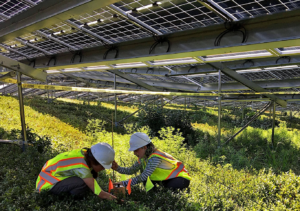
Image Courtesy of UMaine Extension
Wine and CO2

Image Courtesy of Amorim
Bloomberg News reports on the connection between champagne and climate. It’s the corks! They are rooted in the age-old tradition of growing and harvesting cork, a practice that illustrates a form of smart carbon management. Cork oak trees are well-managed, long-term carbon sinks.
Cork oak, quercus suber, is a medium-sized evergreen tree that is the primary source of cork. The tree is native to southwest Europe and northwest Africa, in the Mediterranean basin. It is known to endure droughts and to make little demands on soil quality.
Cork is made from slabs of bark stripped from cork trees. The cork has many uses, best-known for its stoppers for wine and champagne bottles. It was first used by Egyptian and Persians as fishing floats, later by Romans and Greeks for sandals and to seal jars. It was in the late 1700s that cork began its “intimate relationship with wine bottles.”
Today, and in addition to plugging wine bottles, the light spongy material is used in everything from clothing to insulation. It’s used in shoes. It’s also used for flooring and the cores of cricket balls. It insulates cars and high speed trains, even serving on space shuttles. It’s used for the handles of classy fishing rods.
Cork is grown in managed habitats called “montados” in Portugal and “dehesas” in Southern Spain. The cork consists of dead, air-filled thin-walled cells, and contains cellulose and suberin, the latter of which gives it water-repellent properties. The cork layer is replicated by the core producing phellogen and can therefore be harvested repeatedly. Cork trees can live to 400 years old.
Cork is harvested without machinery. At 25 years, typically five “cork strippers” remove the outer bark from the trunk with their bare hands. They use specialized skills to harvest bark without inflicting damage to the tree. First they use their axes to cut deep into the bark. Then they twist their axes and use the handles to prise long cork planks from the tree trunks. If they cut too deep, they injure the trees and future harvests; too shallow and the planks are of insufficient depth for the finest cork stoppers in the wine industry.
Experts say that cork is more sustainable than lumber as it’s harvested from trees that don’t need to be cut down. Cork’s bark regenerates every nine years. Cork itself is the result of carbon sequestration. It is the manifestation of the storage of carbon. Harvesting cork bark assists in the absorption of CO2. Harvested cork trees absorb 3 – 5 times as much CO2 as non-harvested trees. Cork oak trees in Portugal reportedly help offset 10 million tonnes of carbon every year.
According to the proprietor of the Amorim cork empire and the world’s largest producer, Antonio Rios de Amorim, “For every single tonne of cork produced, we are talking about 73 tonnes of CO2 that are captured.” These figures came from a Price Waterhouse study that also determined that every cork stopper accounts for 13.8 ounces of sequestered carbon. Of insulation boards available for builders today, a comparative study found that only cork has a negative carbon footprint.
The downside? It takes a long time to grow a tree mature enough for harvest, typically 25 years. Some thus quip that cork farmers are planting for their grandchildren. This has discouraged some producers; growing olive trees and managing vineyards generates revenues faster. Drip irrigation has the promise of shortening the timeline for cork trees to reach maturity to 10 years… but cork trees normally grow in cork oak forests where one is unlikely to irrigate. Furthermore, cork is increasingly being replaced by other materials as a bottle cap, potentially resulting in a decline of cork oak forests and associated species loss including Iberian Lynx and Imperial Eagles. Makes me want to keep a lookout for cork.
Tesla Moves Into Wireless EV Charging

Image Courtesy of Witricity
Tesla’s move to buy a wireless charging company caught my attention. Will EV charging soon be wireless? Sounds pretty nice. We’ve reported on induction charging before. Just like our electric toothbrushes, in the future it is likely that our cars will charge overnight without a physical connection.
Tesla has recently acquired the German-based company Wiferion. This will allow Tesla to launch its own wireless charging platform. Wiferion is known in Germany for its inductive charging of industrial robots and electric vehicles.
Tesla has reportedly not been very keen on wireless charging believing that it solves a problem that is not very major. EV drivers don’t seem to mind plugging in their cars. It’s much more convenient than going to the gas station!
So why now? Why the acquisition? Pundits speculate that Tesla is getting ready for autonomous vehicles. If they can drive themselves, shouldn’t they be able to charge up by themselves?
French Wind Trees
Wind Trees are being produced by French start-up. Its product is an artificial tree that generates renewable energy. The wind trees have multicolored green “Aeroleafs” on their branches which are small vertical axis wind turbines. New World Wind began by manufacturing prototypes for installations in France, Belgium, and Germany.
Since then, the company has scaled up its operations and it has made trees for clients in France, Switzerland, Sweden, Dubai, Tokyo, New Delhi, and The Netherlands. The locations include a French theme park where visitors can charge their cell phones from the trees’ power.
Each Wind Tree stands 32-feet tall; each Aeroleaf is about 3’ tall. Each tree’s nominal power of 5.4 kW is based on 163 watts per Aeroleaf and 36 leaves per tree. The Aeroleafs’ small blades are optimized for low winds; electromagnetic brakes for each leaf can shut down the mini-turbines in high winds. While not large and powerful, reportedly, they have a track record of “perfect acceptability.”
London’s Bold Climate Action

Just back from travels in four European countries. In each case, we witnessed the fast pace of the green revolution… lots more solar, electric cars, cabs, and lorries, ebikes, and zero emissions in port ships. The green transition that is so evident in California, is equally so in many parts of America, and is exciting in the U.K., Portugal, Spain, and Italy.
Boy are many Brits – including our dear friends who graciously hosted us there again – up in arms about London’s new law to tighten vehicle emissions standards in London. Clearly an initiative with the best of green intentions, it has drawn the ire of the public.
Nevertheless, an Ultra Low Emission Zone (ULEZ) has been established, a ring that circles most of Greater London. All vehicles that enter the zone must meet a stated emissions standard or pay 12.5 British pounds a day ($15.16 USD) to operate there. Older diesels tend to fail.
There is a history of tightening up on emissions in London. In 2008, a scheme to lessen diesel emissions in Central London was put in place. It created a Low Emission Zone (LEZ) that was for commercial vehicles only. The LEZ law was effective in cleaning up London’s buses in Central London, in an area that corresponded with London’s “Congestion Zone.”
In 2015, then Mayor Boris Johnson announced a new law, the Ultra Low Emission Zone (ULEZ). It was planned to go into effect in 2020. In 2017, subsequent mayor Sadiq Khan introduced a “Toxicity Charge.” It preceded the ULEZ which he introduced ahead of schedule.
In April 2019 the ULEZ went into effect in a limited zone for 365 days a year. Fines for non-compliant vehicles were 12.5 pounds per day for cars, vans, and motorcycles, and 100 pounds a day for lorries, buses, and coaches. Within a month, the number of the worst polluting vehicles dropped from 35,578 to 26,195.

Image Courtesy of TFL
The Zone was then extended in 2021, and then again in August 2023, covering almost all of Greater London, resulting in lots of press and complaints. There are loopholes: Vehicles over 40 years in age are considered historic and are exempt, as are cranes, agricultural and military vehicles. Some drivers joke about buying an old, polluting clunker to get around.
There are five million people in the ULEZ. It is estimated that 20 – 40,000 vehicles will be taken off the road as the result of the law. Most of the vehicles – motorbikes, petrol cars, and diesel cars – that are non-compliant are pre-2007, pre-2006, and pre-2015 respectively. Many are paying the fine. In 2022, the Zone brought in 224 million pounds.
A scrappage scheme developed for the Congestion Zone was for those on income support and disabilities and resulted in 12,000 vehicles being taken off the road. Initially participants got up to $8,500 for a car or van operating in the Congestion Zone, plus $3,000 if replaced with an electric vehicle. Later the incentive was dropped. So far the program has paid out $74 million.
London has taken bold steps to cut pollution in Central London, and now to curb emissions throughout Greater London. Its progressive actions are not without challenges. Certainly the law is drawing the ire of many drivers as an ill-conceived and egregious tax. It’s really tough on workers that can’t afford new cars, much less have a place to park and charge an EV. In addition to public sentiment, a study by the Centre for Transport Studies found that the ULEZ is not particularly effective in stemming air pollution, fueling exasperation for those most impacted.
Back to bold action: London is taking a leadership position. This wedge of the climate action pie is tough. The transition to a clean vehicular fleet is painful. The good news is that the air is cleaner and there are fewer GHG emissions, because the most polluting vehicles are being scrapped and replaced.
Flanigan’s Ego-Logic Podcast Updates
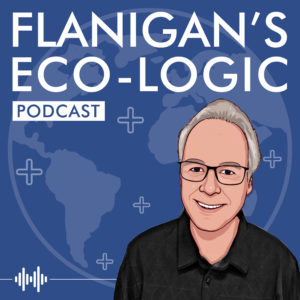
Use the links below to check out our recent podcasts. And you can always go to Spotify and type in “Ted Flanigan” to find our library of podcasts.
Recently Released:
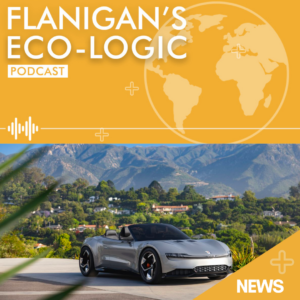
EcoNet News, Volume 25, Issue #9, sheds light on cutting-edge EV technology that get 600+ miles per charge, eliminating EV range anxiety. Ted also highlights the American Climate Corps, the dual use of land for agriculture and solar production, an age-old practice in winemaking that illustrates a form of smart carbon management, Tesla’s move to buy a wireless charging company, an artificial tree that generates renewable energy, and London’s bold climate action.
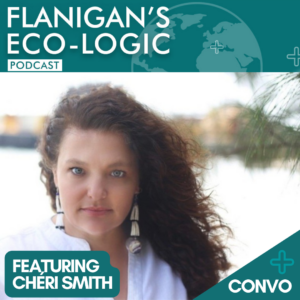
In this episode of Flanigan’s Eco-Logic, Ted speaks with Chéri Smith, President and CEO of the The Alliance for Tribal Clean Energy. ATCE is an Indigenous-led nonprofit that supports the self-determined efforts of Native American tribes transitioning to a clean energy future. It was founded in 2016 by Chéri, and formerly known as the Indigenous Energy Initiative (IEI).
She and Ted discuss the evolution of Indigenous Energy Initiative, from its grassroots origins to becoming the Alliance for Tribal Clean Energy. With the passing of the IRA, The Alliance is providing the critical technical and financial assistance and wrap-around services tribes are currently seeking in order to build their own capacity – to access and manage the historic amounts of federal energy infrastructure and climate funding, and to ensure these historic investments are implemented in an equitable and just way. As a 25-year veteran of the renewable energy sector, Chéri is leveraging her deep experience and relationships to support tribes in their self-determined pursuit of renewable energy as a means to diminish poverty, mitigate climate change, and restore true sovereignty and hope.

In this episode of Flanigan’s Eco-Logic, Ted speaks with Chelsea Congdon, Co-founder of the Global Biodiversity Narrative Project. She also served as a Water Resources Specialist for the Environmental Defense Fund, Water Program Director for Public Council of the Rockies, and is a Film and Media Producer. Chelsea considers herself to be a western water junkie with two decades of work with Natural Heritage Institute (California) and Environmental Defense Fund (western US and Mexico), taking program designs from the energy world and applying them to the water world.
Most recently, she has been consulting on collaborative projects to improve river management, stream flows, and water accountability in Colorado. She also serves on the boards of Western Resource Advocates, Colorado Rocky Mountain School, and Space for Giants. In her current role as co-founder of the Global Biodiversity Narrative Project, Chelsea is deeply engaged in creating and promoting the stories that help people see themselves as a part of nature and engage a broad global movement in transforming relationships with the planet.
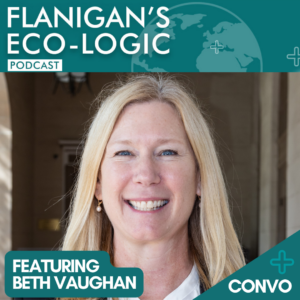
In this episode of Flanigan’s Eco-Logic, Ted speaks with Beth Vaughn, Executive Director at California Community Choice Association. Beth is CalCCA’s first executive director, overseeing the association’s advocacy, policy, and communications efforts, and coordinating a diverse and growing membership of community choice energy providers serving customers across California.
Prior to joining CalCCA, Beth served as executive director of the California Cogeneration Council where she advocated for companies operating combined heat and power facilities. She has worked extensively in both the public and private energy sectors, consulting with government agencies, non-profits, and private sector interests on energy, climate, and environmental public policy issues. In her current role, she frequently presents CalCCA’s positions on various policy issues at the California Legislature and California Public Utilities Commission and is a regular speaker at energy industry events.

In this episode of Flanigan’s Eco-Logic, Ted speaks with Laura Friedman, California State Assemblymember, 44th District. Her legislative work is focused in three primary areas: addressing the housing affordability and homelessness crisis, combating climate change, and protecting vulnerable communities. She has authored a package of bills to create new avenues for communities to tackle the affordable housing crisis, encourage water conservation, strengthen environmental sustainability, protect communities against devastating wildfires, improve access to higher education and health care, and ensure that California’s foster youth have the support that they need as they transition to adulthood.
Building on her years of community service, she was elected to the Glendale City Council in 2009, served as Mayor from 2011 through 2012, and was re-elected in 2013, successfully pushing the City to execute all kinds of green initiatives. She also highlights her time in the Assembly, securing over $60 million in funding for key projects across the District, being tapped for several leadership roles in the Legislature, including the Assembly Select Committee on Urban Development to Combat Climate Change, and being recognized as a steadfast advocate for the environment, sustainable communities, and active transportation. Laura is now running for US congress to be the Representative for the 30th Congressional District in the State of California.
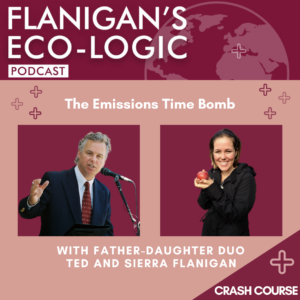
In this episode of Flanigan’s Eco-Logic, father-daughter duo, Ted and Sierra Flanigan host the clean energy crash course focusing on the Emissions Time Bomb, a representation of the average person in California’s carbon footprint – 1 metric ton of CO2 per month. After some research, the vision was born and the EcoMotion team decided to build the display to scale.
Ted and Sierra then get into the details and discuss the ultimate use, which was to raise awareness about climate issues in the communities, as well as creating the full fledged Save a Ton campaign. The goal of the campaign was to try to get people to save 1 ton, or 1/12th of their annual emissions. While its primary use was in the Coachella Valley for work funded by Southern California Edison, the Bomb was used in many cities in Southern California and even made a road trip to New England, where it ended its eight-campus tour at Yale University.
Ted concludes by sharing that the Emissions Time Bomb ultimately fulfilled its mission and is now looking for a new home! He asks listeners to reach out if they know of any organizations that would have interest in the donation.
